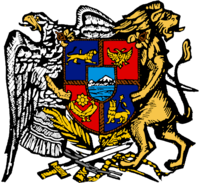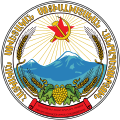Arms of Armenia
| Arms of Armenia | |
|---|---|

|
|
| Details | |
| Introduced | April 19, 1992 |
| Shield shape and division | divided into four |
| Sign holder | Eagle , lion |
| Previous versions |

Coat of arms of the Democratic Republic of Armenia (1918–1922)
|
The Law “On the State Coat of Arms of the Republic of Armenia ” was passed on April 19, 1992 by the Supreme Soviet of the Republic of Armenia . This reintroduced a slightly modified version of the national coat of arms of the Democratic Republic of Armenia (1918–1922). It was created by the architect Alexander Tamanjan and the artist Hakob Kodschojan .
Symbols and meaning
The Armenian coat of arms is divided into four in red and blue and shows the coats of arms of the four Armenian royal houses Artaschesian , Arshakuni , Bagratuni and Rubinian ( Kingdom of Lesser Armenia ).
On a golden central shield it contains Mount Ararat , on which the contours of Noah's Ark are depicted. On the left ( heraldic right ) there is a golden eagle and on the right (heraldic left) a golden lion , holding the shield as a coat of arms holder and opposing both. They are symbols of the Armenian Apostolic Church and the royal family of the Bagratids and stand for spiritual strength and power, steadfastness and courage. Furthermore, the coat of arms is adorned with an upright golden sword with a carefully broken chain as a symbol of the struggle of the Armenian people for freedom and independence, and under the shield a bundle of ears of corn and a branch crossed in gold as symbols of creativity and peacefulness.
Historical coat of arms
The symbols of the earlier version of the coat of arms, used between 1918 and 1922, were arranged in a slightly different order, and the coat of arms holders, the eagle and the lion, showed their tongues. Only Mount Ararat, together with the so-called Little Ararat, were shown, while Noah's Ark was still missing from the earlier coat of arms.
In 1922, Armenia was included with Georgia and Azerbaijan in the Transcaucasian SFSR , whose government adopted a new coat of arms, see coat of arms of the Transcaucasian SFSR . It contains symbolism related to each of the three major population groups, the Armenians, the Azeris and the Georgians.
After the end of the Transcaucasian SFSR, a new coat of arms was adopted by the now founded Armenian SSR in 1936 , see Coat of Arms of the Armenian SSR . As in the coat of arms of the first independent Armenian republic, Mount Ararat was depicted here, together with the Soviet hammer, sickle and red star that were prominently placed above Mount Ararat. With the collapse of the Soviet Union, Armenia became an independent republic again, which in 1992 adopted a slightly modified version of the coat of arms of the first republic. This coat of arms has been retained to this day.
See also
Individual evidence
- ↑ Hofmann, Tessa: Approaching Armenia. Past and present, 2nd edition, Munich 2006, pp. 143–144.

